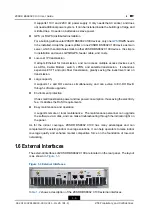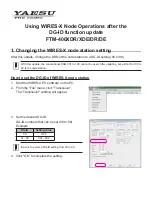
ZXSDR BS8802 C100 User Guide
illustrates the 1.9 GHz receiver indices.
Table 3-5 1.9 GHz Receiver Indices
Name
Index
Operating band
1.9G Hz (Band Class 1&14)
Receiver sensitivity
< -121 dBm
Receiver dynamic range
When the lower limit is the receiver sensitivity and the upper
limit (noise level) equals - 55 dBm/1.23 MHz (Eb/N0 =
10dB±1dB), the Frame Error Rate (FER) is lower than 1%.
Noise figure
< 3
Adjacent channel selection (ACS)
Band Class 6:> - 53dBm (± 2.5M)
Single tone desensitization
In the presence of a single tone that is 50 dB above the
CDMA signal level, and is at offset of ± 750 kHz from the
center frequency, the output power of the MS increases by
no more than 3 dB ,and the FER is less than 1.5%.
In the presence of a single tone that is 75 dB above the
CDMA signal level, and is at offset of ± 900 kHz from the
center frequency, the output power of the MS increases by
no more than 3 dB, and the FER is less than 1.5%.
Intermodulation spurious response
attenuation
In the presence of two interfering tones that are 60 dB
above the CDMA signal level, and are at offsets of 1.25
MHz and 2.05 MHz, and -1.25 MHz and -2.05 MHz from
the center frequency, the output power of the MS increases
by no more than 3 dB, and the FER is less than 1.5%.
Conducted spurious emissions and
radiated spurious emissions
< -80 dBm, measured within the BTS receive band
< -60 dBm, measured within the BTS transmit band
Radio frequency Front End SWR
< 2.0
3.8 BTS Clock Technical Parameters
l
BTS clock technical parameters
Frequency benchmark: 10 MHz, in locked GPS status, the accuracy of the frequency
is superior to 10
-10
; in holding status, the accuracy of the frequency is superior to 10
-10
.
Temperature characteristics: < ± 1×10
-8
l
Clock synchronous source
If the clock synchronous source is lost temporarily or the base station clock falls out
of step, to keep the short-term stability of the clock, the HOLDOVER algorithm can be
adopted to assure the normal operation of the base station when the sync signal gets
lost, so that the phase drift within 4 hours is superior to 10µs.
3-6
SJ-20110329145303-001|2011–10–25 (R1.1)
ZTE Proprietary and Confidential
















































